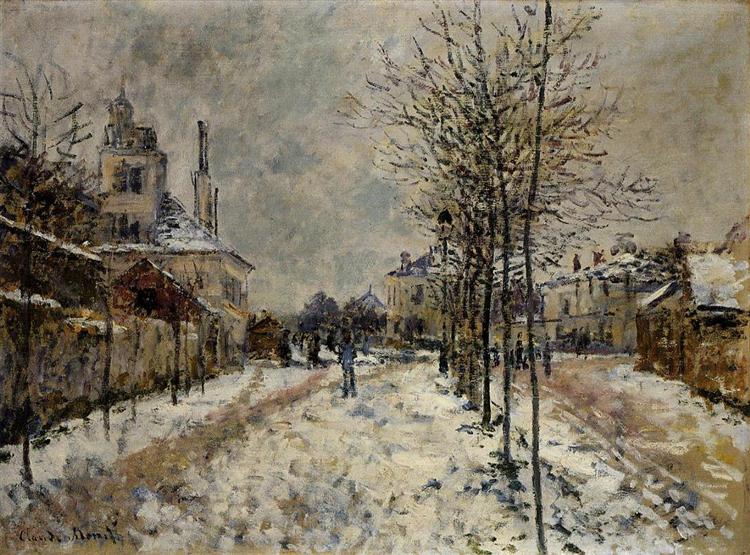Description
In "snow effect - Pontoise's boulevard in Argenteuil" (1875), Claude Monet presents us with a work that encapsulates the essence of impressionism, a movement that he himself helped to define and popularize. The painting, which captures a particular moment of life in nineteenth -century France, immerses us in a landscape covered with snow, where the winter atmosphere becomes almost palpable through the interaction of color and light.
The composition reveals a careful disposition of elements that offer a narrative that transcends the merely visual. Monet, when choosing to represent a boulevard of Argenteuil, a place that knew well, transforms a simple daily scenario into a celebration of light and color. The central path of the scene is flanked by trees whose branches dress in white, creating a beautiful contrast with the darkest and foggy background. Through the delicate and loose brushstrokes, Monet manages to transmit the texture of the snow, creating an atmosphere of serenity and stillness.
The use of the color palette is one of the most prominent aspects of this work. Cold tones predominate, with soft nuances of blue and gray that evoke the coldness of winter. At the same time, some warmer touches, such as yellow and gold that emerge in buildings and the road, suggest the struggle between human heat and the ice of nature, instilling life to the scene. This juxtaposition of warmth and coldness in color terms not only provides depth, but also invites the viewer to reflect on the relationship between the human being and its surroundings.
Although painting does not have clearly defined human figures, the presence of people is insinuated through fingerprints in snow and forms vaguely suggested in the background. This leaves the observer with a sense of mystery, wondering about the history of those who have traveled through this winter landscape. The absence of a clear human focus could also be interpreted as a statement on the insignificance of the human being against the vastness of nature, a recurring theme in the art of Monet and in impressionism in general.
In the context of its production, "Snow Effect" stands out as an exploration of the Light Phenomenon on snow, a theme that Monet addressed on several occasions throughout his career. Through his work, the artist challenged the conventions of representation, breaking with the academic tradition of his time. This piece is a magnificent example of how Monet used the fast brushstroke technique and a vibrant color palette to capture the fleeting essence of the moment.
In addition, it is important to mention that during this period, Monet was very interested in the study of light and atmospheric effects, bringing his art to a more experimental approach. "Snow effect" is not only a representation of a landscape, but also a study of the emotional and visual impact that snow and winter can evoke. The atmosphere that is generated in the work is both contemplative and introspective, inviting the spectator to get lost in the splendor of the winter landscape.
In conclusion, "snow effect - Pontoise's boulevard in Argenteuil" is a work that not only illustrates the winter experience, but also serves as a powerful reminder of Monet's genius to capture light and emotion in painting. It is a testimony of its ability to transform the ordinary into something extraordinary, a distinctive feature that characterizes it as one of the pillars of impressionism and a lighthouse of innovation in art history.
KUADROS ©, a famous paint on your wall.
Hand-made oil painting reproductions, with the quality of professional artists and the distinctive seal of KUADROS ©.
Reproduction service paintings With a guarantee of satisfaction. If you are not completely satisfied with the replica of your painting, we refund your money 100%.

